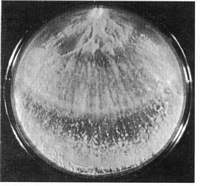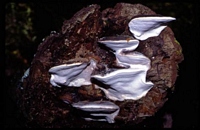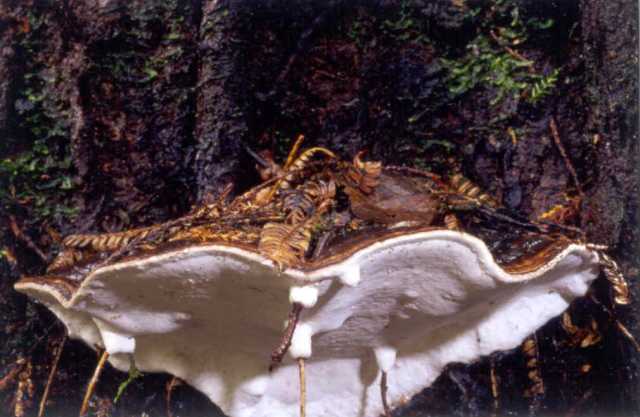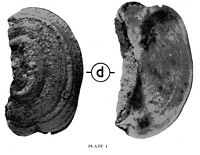|
 Fomes hemitephrus Fomes hemitephrus
SynonymsFomes pinicola
Fomitopsis hemitephra
Fomes fraxineus
Fomes hornodermus
Heterobasidion hemitephrum
Polyporus hemitephrus
Trametes hemitephra
BiostatusPresent in region - Indigenous. Non endemic
Images (click to enlarge)
Caption: Fig. 1 Fomes hemitephrus (BAFC/cc 495). Aspect of the mat after 6 weeks of growth. | 
Caption: Fig. 2 Fomes hemitephrus (BAFC/cc 495). Microscopic cultural characters: A, generative
hyphae; B, fibre hyphae; C, cuticular cells. | 
Owner: P.K. Buchanan | 
Caption: specimen RR NZ05
Owner: Richard Robinson | 
Caption: x ½. Upper and lower surfaces of a pileus. |
Article: Rajchenberg, M. (1995). Notes on New Zealand polypores (Basidiomycetes) 2. Cultural and morphological studies of selected species. New Zealand Journal of Botany 33(1): 99-109 (http://www.rsnz.org/publish/abstracts.php).
Description: MACROSCOPIC CHARACTERS (Fig. 1): Growth rapid, dishes covered in 3 weeks.
Growing margin regular, felty-farinose. Mat first woolly with denser radial stripes near
the inoculum. At week 6, mat white, tightly felty to plaster-like at the margin, with or
without sunken areas. In the centre becoming loose felty to woolly. Around the
inoculum it is tightly felty. Pale yellow areas are present in the subfelty and/or felty
areas. Mat growing on the glass and then presenting orange-yellow tints. Reverse
bleaching. Odour acidic or none.
OXIDASE REACTIONS: tannic acid: ++++, trace gallic acid: ++++, 0 mm tyrosinase: -, 12 mm
MICROSCOPIC CHARACTERS (Fig. 2): Marginal hyphae regularly clamped, 3-4(-5)
µm diam., thin-walled and sparsely branched. Woolly, felty, and plaster-like areas with
many aerial fibre hyphae, 1-1.5(-2.0) µm diam., branched, with hyaline, slightly
thickened walls. Pale yellow subfelty areas with submerged mycelium differentiated
into cuticular cells that form pseudoparenchymatous areas, with cell walls thickened up
to 1-3.5 µm.
SEXUALITY: Seemingly tetrapolar. Ten single monospore cultures were distributed as:
A1B1:1,2,3,4,6,8; A2B2: 9, 10; AXBX: 5, 7
NUCLEAR BEHAVIOUR: Normal.
CODE: 2.3c.8.10.32.36.37.40.43.54.60.61
Notes: REMARKS: Fomes hemitephrus is one of the most common polypores in New Zealand
and Australia, and it damages several tree species. Nevertheless, no detailed study of its
cultural features has been reported. Refshauge & Proctor (1935) only gave general
features. Stalpers' (1978) report of this species in culture does not support the fact that
the species causes a white rot in wood and was perhaps based on an old culture or a
different taxon. Good basidiome descriptions may be found in Cunningham (1965) and
Teixeira (1962).
Fomes hemitephrus has been included or accepted in Fomitopsis Karst. (Cunningham
1948; Ryvarden 1977), Heterobasidion Bref. (Cunningham 1965), and Trametes Fr.
(Corner 1989). Teixeira (1962) supports the disposition of this species in Fomes (Fr.)
Fr., a disposition with which I concur because of the following characteristics:
perennial fruit body, trimitic hyphal system, smooth, hyaline, cylindric spores, pileus
covered with a hard smooth crust, production of a white rot, tetrapolar sexuality,
production of cuticular cells in culture, and normal nuclear behaviour.
Fomitopsis includes brown wood-rotting species with bipolar sexuality, and most of the
species produce generative hyphae with irregularly thickened walls in culture (Carranza-Morse &
Gilbertson 1989); hence, the species does not belong in Fomitopsis, as suggested by
Hood (1992). Although currently known in New Zealand as Heterobasidion hemitephrus
(Berk.) G.H. Cunn. due to Cunningham (1965), Fomes hemitephrus cannot be included in
Heterobasidion Bref. Heterobasidion is restricted to fomitoid species with a dimitic hyphal
system of simple-septate generative hyphae and skeletal hyphae, and with asperulate spores.
Ryvarden (1977) stated that Cunningham's concept of Heterobasidion was too broad. Some
support that Heterobasidion is related to the Bondarzewiaceae (Stalpers 1980; Gluchoff-Fiasson et al.
1983). The inclusion of F. hemitephrus in Trametes by Corner (1989) is also
not accepted here. It is beyond the limits of that genus (Ryvarden 1991) which includes
annual species, lacking a crust on the pileus.
Fomes hemitephrus differs from the type species of the genus, F. fomentarius (L.:Fr.)
Kickx., in its creamy to light chestnut colouration of the context and dissepiments, and the
lack of sclerids in the context (Gilbertson & Ryvarden 1986). Nevertheless, it shares all other
morphological features. I note also that it develops cuticular cells in culture as does F.
fomentarius. This character is rarely seen in cultures of trametoid and fomitoid species
(Nobles 1965; Stalpers 1978).
Article: Gadgil, P.D. (in association with Dick, M.A.; Hood, I.A.; Pennycook, S.R.) (2005). Fungi on trees and shrubs in New Zealand. Fungi of New Zealand. Ngā Harore o Aotearoa 4: xi + 437 p. Hong Kong: Fungal Diversity Press.
Description: Type: Lignicolous Fungi; Description: Basidiomata perennial, solitary, hard, leathery or woody, attached by a broad lateral base. Pilei applanate or ungulate, 30–200 mm wide, 10–100 mm thick. Pileus surface tomentose, becoming glabrous, strongly concentrically sulcate, often banded in different shades of brown or grey, becoming deep brown to umber with age. Pore surface slightly convex, with a narrow sterile border 2–3 mm wide, white, pores in many strata, small, 6–7 per mm. Context cream, often zoned, up to 15 mm thick; in cross-section, a thin orange line is visible immediately beneath the pileus surface. Hyphal system dimitic. Basidiospores elliptic-oblong, 4–6 × 2–3 μm, smooth, hyaline.
Distribution: Distribution: Northland, Auckland, Coromandel, Waikato, Bay of Plenty, Taranaki, Taupo, Wanganui, Wellington, Gisborne, Hawkes Bay, Wairarapa, Nelson, Buller, Westland, Fiordland, Marlborough, Mid Canterbury, Otago Lakes, Dunedin, Southland, Stewart Island.; 1st Record: Colenso (1887: as Fomes (Laevi) hemitephrus).
Article: Cunningham, G.H. (1948). New Zealand Polyporaceae. 5. The genus Fomitopsis. New Zealand Department of Scientific and Industrial Research, Plant Diseases Division, Bulletin 76: 8 p.
Description: Hymenophore perennial, solitary, dimidiate, hard and woody. Pileus applanate or ungulate, variable in size and shape, 3-20 cm. x 3-12 cm. x 1-10 cm.; surface at first ochraceous or fawn, even and finely tomentose, becoming bay brown banded with greyish zones, tobacco- or fuscous-brown and concolorous, umber or in old specimens sometimes black, strongly concentrically sulcate, often banded with zones of different shades of grey or brown, more numerous and narrower peripherally, cuticle to 1 mm. thick, firm, ligneous, brittle, chestnut brown with an orange zone in the context immediately beneath, composed of hyphae with chestnut brown walls, densely woven and firmly cemented in mucilage; margin bluntly rounded, or thickened and formed from numerous equal layers, then laterally sulcate; hymenial surface at first white or cream, even, with rounded sterile margin 2-3 mm. wide, plane, slightly concave or as often convex, drying isabelline, or darker, dissepiments not toothed. Context cream or isabelline, floccose, firm, to 15 mm. thick, often zoned; skeletal hyphae 3.5-4 μ thick, lumen 2 μ or less, long type, aseptate, sparsely branched and undulate near ends, staining blue; generative hyphae 2-3 μ thick, thin walled, sparsely branched, septate only in the subhymenium, not staining. Pores in many often obscure strata, sometimes with bands of context between layers, round or slightly angular, in section wood colour, 3-10 mm. deep in each layer, 50-150 μ diameter, or 6-7 per mm.; dissepiments 50-200 μ thick, commonly 75-100 μ, equal, apices even. Basidial type clavate, basidia clavate, 8-10 x 4-5 μ, soon collapsing. Spores elliptic-oblong, or subcylindrical, 1-6 x 2-2.5 μ, smooth, hyaline.
Distribution: Australia; New Zealand.
Notes: As with many perennial species the hymenophore exhibits considerable diversity in form, size, and colour. Commonly applanate, specimens may also be ungulate, or even resupinate, though this last condition is rare. Each successive pore layer may grow to the edge of the preceding, when the margin becomes thick and banded with as many sulcate zones as there are pore layers. Or successive layers may recede, forming islands or producing irregular obconic hymenophores. Pores may be in definite strata, each defined by a differently coloured line, or by layers of context hyphae; in other specimens they may be obscurely stratose or appear to be continuous. Many stratose specimens possess a well developed ligneous cuticle; but in first year plants this is poorly developed or wanting, the surface often being finely tomentose and azonate. The basidial type is clavate, though in a former paper (1947) I erroneously stated that in both F. annosa and F. hemitephra it was of the honeycomb type. The hymenial laver (as in all species recorded herein) soon collapses after spores are shed and appears on walls of dissepiments as a formless mucilaginous film.
According to overseas workers the species resembles closely “Fomes” hormodermus Mont. Lloyd (1915, p. 215), in fact, recorded the latter from New Zealand, basing his record on specimens of F. hemitephra. The latter differs in the elliptic-oblong spores, smaller pores and presence of an orange zone in the context beneath the cuticle. Sometimes this last feature is absent, especially from young specimens; it may then be seen where the hymenophore junctions with the host. Occasionally the surface of the wood is stained orange.
Article: Cunningham, G.H. (1965). Polyporaceae of New Zealand. New Zealand Department of Scientific and Industrial Research, Bulletin 164: 304 p. Wellington:.
Description: Hymenophore perennial, solitary, hard and woody, attached by a broad lateral base. Pilei applanate or ungulate, 3-20 cm wide, 3-12 cm radius, 1-10 cm thick; pileus surface at first ochre or fawn, becoming bay banded with greyish zones, tobacco brown or fuscous and concolorous, umber in old specimens or sometimes black, strongly concentrically sulcate, often concentrically banded with different shades of brown, finely tomentose becoming glabrous; cortex to 1 mm thick, chestnut with an orange zone beneath, ligneous, brittle, composed of densely intertwined cemented hyphae with chestnut walls; margin bluntly rounded, or thickened and formed from numerous equal growth layers when concentrically sulcate; hymenial surface at first white or straw, drying isabelline, even, slightly concave or as often convex, with a narrow rounded sterile border 2-3 mm wide. Pores in many often obscure strata (2-18), sometimes with zones of context hyphae between, 3-10 mm deep in each layer, wood colour, round or slightly angular, 6-7 per mm, 50-150 µm diameter; dissepi-ments 50-200 µm thick, commonly 75-100 µm, equal, apices even. Context cream or isabelline, to 15 mm thick, often zoned, of densely intertwined hyphae; skeletal hyphae to 4 µm thick, lumena 1.5-2 µm diameter, aseptate, scantily branched and undulate near ends, staining; generative hyphae to 3 µm diameter, walls thin, not staining, sparsely branched, septate in the subhymenium. Hymenial layer to 20 µm deep, a loose palisade of basidia and paraphyses, soon collapsing. Basidia clavate, 8-10 x 4-5 µm bearing 4 spores; sterigmata erect, to 4 µm long. Paraphyses subclavate, 6-8 x 3.5-4 µm. Spores elliptic-oblong, 4-6 x 2-2.5 µm walls smooth, hyaline, 0.1 µm thick.
Habitat: Bark or decorticated wood of standing or fallen trunks, associated with a white heart rot.
Distribution: New Zealand, Australia, Samoa.
Notes: One of the most common species in New Zealand, which may be recognised by the usually dark colour of the strongly sulcate pileus surface, conspicuous cortex with an orange zone between it and the context, small pores, usually numerous pore layers, and small elliptical spores. Commonly applanate, pilei may be ungulate or resupinate; each successive pore layer may grow to the edge of the preceding when the margin becomes thick and banded with many concentric sulcate zones, or successive layers may recede, forming islands or irregular obconic fructifications. Pores may be in definite strata each defined by a differently coloured line, or by layers of context hyphae; or in other collections pores may be obscurely stratose, or even appear to be continuous. The hymenial layer soon collapses and appears on walls of dissepiments of mature plants as an amorphous mucilaginous film.
Lloyd (1915a, µm. 215) recorded the species from New Zealand as Fomes hormodermus and from Australia as F. martius. From these Heterobasidion hemitephrum may be separated by the different spores, smaller pores and presence of an orange zone in the context beneath the cortex. This last feature may be absent from young plants, but may be seen where fructifications are in contact with the substratum, and occasionally the surface of the wood is stained orange.
Article: Cooke, M.C. (1879). New Zealand fungi. Grevillea 8(46): 54-68.
|